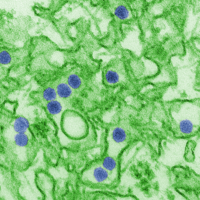
Photo from wikipedia
Significance Zika virus (ZIKV) was discovered 70 years ago, and since then small isolated outbreaks occurred without major complications being reported. When ZIKV hit Brazil, however, a public health emergency… Click to show full abstract
Significance Zika virus (ZIKV) was discovered 70 years ago, and since then small isolated outbreaks occurred without major complications being reported. When ZIKV hit Brazil, however, a public health emergency was declared, given its link with microcephaly. Knowledge on ZIKV has advanced, but demographic impacts remain poorly understood. This study uses data from Brazil to assess whether a decline in births occurred after the onset of ZIKV. Forecasts show significant birth declines, particularly after April 2016. No significant changes in fetal death rates and no pattern of increase in hospitalizations due to abortion complications were observed, although hospitalizations occurred later in some states. We argue that postponement of pregnancy and abortions, primarily, likely affected fertility, with implications for women’s reproductive health. An increase in microcephaly, associated with an epidemic of Zika virus (ZIKV) in Brazil, prompted the World Health Organization to declare a Public Health Emergency of International Concern in February 2016. While knowledge on biological and epidemiological aspects of ZIKV has advanced, demographic impacts remain poorly understood. This study uses time-series analysis to assess the impact of ZIKV on births. Data on births, fetal deaths, and hospitalizations due to abortion complications for Brazilian states, from 2010 to 2016, were used. Forecasts for September 2015 to December 2016 showed that 119,095 fewer births than expected were observed, particularly after April 2016 (a reduction significant at 0.05), demonstrating a link between publicity associated with the ZIKV epidemic and the decline in births. No significant changes were observed in fetal death rates. Although no significant increases in hospitalizations were forecasted, after the ZIKV outbreak hospitalizations happened earlier in the gestational period in most states. We argue that postponement of pregnancy and an increase in abortions may have contributed to the decline in births. Also, it is likely that an increase in safe abortions happened, albeit selective by socioeconomic status. Thus, the ZIKV epidemic resulted in a generation of congenital Zika syndrome (CZS) babies that reflect and exacerbate regional and social inequalities. Since ZIKV transmission has declined, it is unlikely that reductions in births will continue. However, the possibility of a new epidemic is real. There is a need to address gaps in reproductive health and rights, and to understand CZS risk to better inform conception decisions.
Journal Title: Proceedings of the National Academy of Sciences of the United States of America
Year Published: 2018
Link to full text (if available)
Share on Social Media: Sign Up to like & get
recommendations!